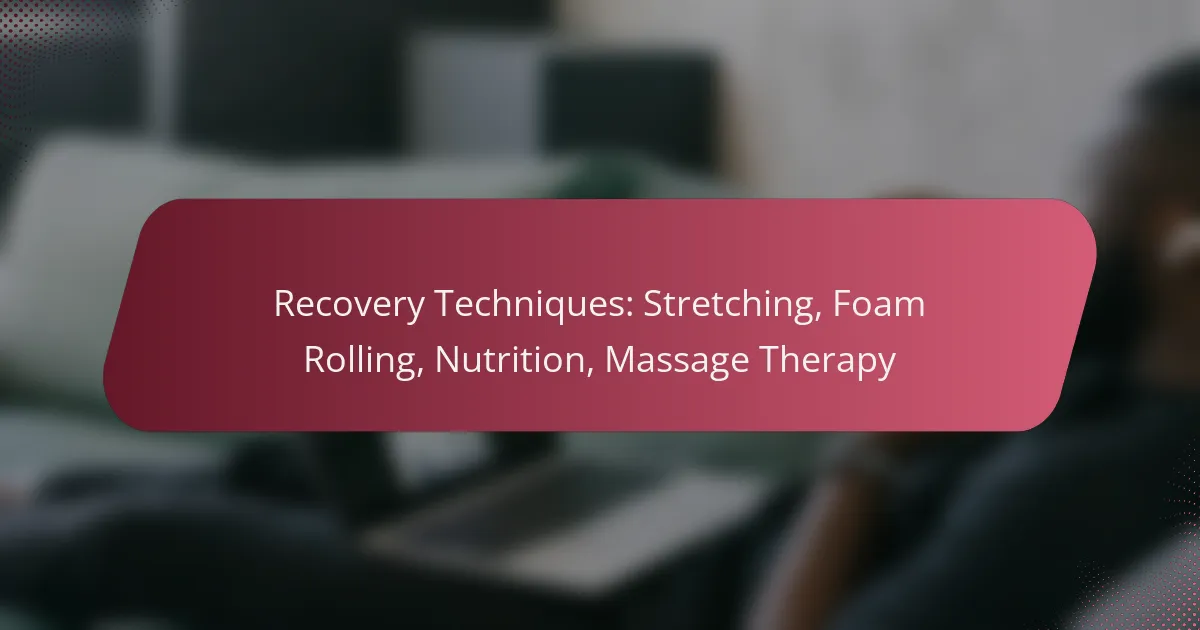Recovery is essential for athletes to maintain peak performance and prevent injury, and effective techniques include stretching, foam rolling, proper nutrition, and massage therapy. These methods not only enhance flexibility and reduce muscle soreness but also promote overall recovery after intense physical activity. Incorporating these practices into a regular routine can lead to improved movement, performance, and long-term athletic success.

What are effective recovery techniques for athletes in Ireland?
Effective recovery techniques for athletes in Ireland include stretching, foam rolling, proper nutrition, and massage therapy. These methods help enhance flexibility, reduce muscle soreness, and promote overall recovery after intense physical activity.
Stretching for flexibility and injury prevention
Stretching is crucial for maintaining flexibility and preventing injuries among athletes. Incorporating dynamic stretches before workouts and static stretches afterward can improve range of motion and reduce muscle tightness.
Focus on major muscle groups such as hamstrings, quadriceps, and shoulders. Holding static stretches for 15-30 seconds can be beneficial, while dynamic stretches should be performed in a controlled manner for about 5-10 minutes before activity.
Foam rolling for muscle recovery
Foam rolling is an effective self-myofascial release technique that helps alleviate muscle soreness and improve blood flow. By applying pressure to specific muscle groups, athletes can release tension and enhance recovery.
Spend about 1-2 minutes on each muscle group, focusing on areas that feel tight or sore. Common areas to target include the calves, thighs, and back. Avoid rolling directly over joints or bones to prevent injury.
Nutrition for optimal recovery
Proper nutrition plays a vital role in recovery for athletes. Consuming a balanced diet rich in carbohydrates, proteins, and healthy fats can help replenish energy stores and repair muscle tissue after exercise.
Aim for a post-workout meal or snack that includes a combination of protein and carbohydrates within 30-60 minutes after training. Examples include a protein shake with a banana or chicken with sweet potatoes. Staying hydrated is equally important, so drink plenty of water throughout the day.
Massage therapy for muscle relaxation
Massage therapy is an excellent way to promote muscle relaxation and recovery. It can help reduce muscle tension, improve circulation, and alleviate soreness, making it a popular choice among athletes.
Consider scheduling regular massages, especially after intense training sessions or competitions. Techniques such as deep tissue or sports massage can be particularly beneficial. Always communicate with your therapist about any areas of discomfort to ensure a tailored experience.

How does stretching aid recovery?
Stretching aids recovery by enhancing blood flow to muscles, which promotes healing and reduces stiffness. It also helps maintain flexibility, allowing for better movement and performance in subsequent activities.
Improves flexibility
Stretching is essential for improving flexibility, which is the range of motion around a joint. Regular stretching can increase muscle elasticity, making it easier to perform daily activities and reducing the risk of injury during physical exertion.
To effectively improve flexibility, incorporate dynamic stretches before workouts and static stretches afterward. Aim for at least 10-15 minutes of stretching several times a week to see noticeable improvements.
Reduces muscle soreness
Stretching can help reduce muscle soreness after exercise by promoting circulation and flushing out metabolic waste products. This can lead to faster recovery times and less discomfort following intense workouts.
To minimize soreness, focus on gentle static stretches targeting the major muscle groups used during your workout. Hold each stretch for 15-30 seconds, and consider incorporating stretching into your cool-down routine to maximize its benefits.

What are the benefits of foam rolling?
Foam rolling offers several benefits, primarily enhancing recovery by improving blood circulation and alleviating muscle tightness. This self-myofascial release technique can be an effective addition to your post-workout routine, helping to prepare your muscles for future workouts.
Increases blood flow
Foam rolling increases blood flow to the muscles, which is crucial for recovery. Improved circulation helps deliver oxygen and nutrients while removing metabolic waste, promoting faster healing. Regular use can enhance overall performance by ensuring your muscles are well-nourished.
To maximize blood flow benefits, spend about 1-2 minutes on each muscle group, applying moderate pressure. Focus on areas that feel particularly tight or sore, as these are often where circulation is restricted.
Relieves muscle tightness
Foam rolling effectively relieves muscle tightness by breaking down adhesions and knots in the fascia, the connective tissue surrounding muscles. This process can lead to increased flexibility and a greater range of motion, which is essential for athletic performance.
When foam rolling, target specific areas like the quadriceps, hamstrings, and calves. Aim for 1-3 sets of rolling each area for 30 seconds to 1 minute, adjusting pressure based on your comfort level. Avoid rolling directly over bones or joints to prevent injury.

How important is nutrition in recovery?
Nutrition plays a critical role in recovery by providing the necessary nutrients for muscle repair and energy replenishment. A well-balanced diet supports overall recovery processes, helping athletes and active individuals bounce back more effectively after physical exertion.
Supports muscle repair
Proper nutrition is essential for muscle repair, primarily through the intake of protein. Consuming high-quality protein sources, such as lean meats, dairy, legumes, and nuts, can facilitate muscle recovery by supplying amino acids needed for tissue repair. Aim for a protein intake of around 1.2 to 2.0 grams per kilogram of body weight, depending on activity levels.
In addition to protein, vitamins and minerals, particularly those found in fruits and vegetables, contribute to muscle recovery by reducing inflammation and oxidative stress. Nutrients like vitamin C, vitamin E, and zinc are particularly beneficial in this regard.
Replenishes energy stores
After intense physical activity, it is vital to replenish energy stores, primarily glycogen, which is stored in muscles and the liver. Consuming carbohydrates post-exercise can help restore these glycogen levels. A general guideline is to consume about 1 to 1.5 grams of carbohydrates per kilogram of body weight within 30 minutes after exercise.
Incorporating a mix of simple and complex carbohydrates, such as fruits, whole grains, and starchy vegetables, can optimize glycogen replenishment. Additionally, pairing carbohydrates with protein in recovery meals can enhance overall recovery and muscle repair.

What role does massage therapy play in recovery?
Massage therapy plays a significant role in recovery by promoting muscle relaxation and enhancing overall well-being. It aids in the recovery process by improving blood circulation, reducing muscle soreness, and facilitating the removal of metabolic waste from the body.
Enhances relaxation
Massage therapy enhances relaxation by stimulating the parasympathetic nervous system, which helps to lower heart rate and blood pressure. Techniques such as Swedish massage focus on long, gliding strokes that promote a deep state of relaxation, allowing the body to recover from physical exertion.
Incorporating regular massage sessions into your routine can significantly improve your mental state and physical comfort. Aim for a session of 60 to 90 minutes every few weeks to maintain optimal relaxation levels.
Reduces stress and tension
Massage therapy effectively reduces stress and tension by targeting tight muscles and releasing built-up knots. This process not only alleviates physical discomfort but also helps to decrease cortisol levels, the hormone associated with stress.
To maximize the benefits, consider combining massage with other recovery techniques, such as stretching or foam rolling. Establishing a consistent schedule, such as weekly or bi-weekly sessions, can help maintain lower stress levels and promote better overall recovery.

What criteria should be considered when choosing recovery techniques?
When selecting recovery techniques, consider factors such as individual fitness goals, the type of physical activity performed, and personal preferences. These criteria help tailor recovery methods to enhance performance and prevent injury effectively.
Individual fitness goals
Your recovery techniques should align with your specific fitness objectives, whether it’s building strength, improving endurance, or enhancing flexibility. For example, if your goal is muscle growth, incorporating techniques like foam rolling and massage therapy can aid in muscle recovery and reduce soreness.
Conversely, if you aim to increase flexibility, stretching should be a primary focus. Assess your goals regularly and adjust your recovery strategies to ensure they remain effective and relevant.
Type of physical activity
The nature of your physical activity significantly influences your recovery choices. High-intensity workouts, such as sprinting or weightlifting, may require more intensive recovery methods like massage therapy or foam rolling to alleviate muscle tightness and soreness.
On the other hand, low-impact activities, such as yoga or walking, might benefit more from gentle stretching and proper nutrition to support recovery. Tailor your recovery techniques to match the demands of your workouts for optimal results.

What are advanced recovery techniques for athletes?
Advanced recovery techniques for athletes include methods that enhance physical recovery, reduce muscle soreness, and improve overall performance. These techniques, such as active release therapy, foam rolling, and proper nutrition, can significantly aid in faster recovery and injury prevention.
Active release therapy
Active release therapy (ART) is a manual therapy technique that targets soft tissue injuries and muscle tightness. It involves a practitioner applying pressure to specific areas while the athlete actively moves the affected muscle, promoting blood flow and releasing tension.
During a session, the therapist assesses the athlete’s movement patterns and identifies areas of restriction. By using precise movements and pressure, ART can alleviate pain, improve flexibility, and enhance overall function. Athletes often report feeling immediate relief after treatment.
For optimal results, consider scheduling ART sessions regularly, especially during intense training periods. It’s essential to communicate openly with the therapist about any discomfort or specific areas of concern to tailor the treatment effectively.
